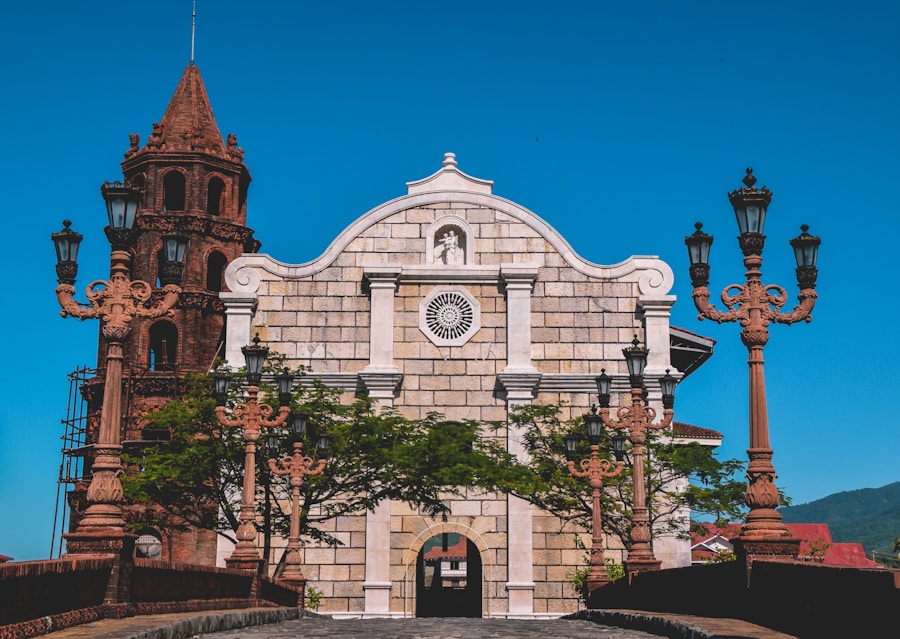Download links
How to install Manila Cathedral: A Historic Landmark APK?
1. Tap the downloaded Manila Cathedral: A Historic Landmark APK file.
2. Touch install.
3. Follow the steps on the screen.
Description
The Manila Cathedral, officially known as the Cathedral-Basilica of the Immaculate Conception, has a rich and storied history that reflects the broader narrative of the Philippines itself. Its origins can be traced back to 1581 when the first church was constructed on the site, serving as the seat of the Archdiocese of Manila. This initial structure was made of bamboo and nipa palm, a humble beginning that belied the cathedral’s future significance.
Over the centuries, the cathedral has undergone numerous reconstructions and renovations, each reflecting the prevailing architectural styles and the socio-political climate of the time. The cathedral has been rebuilt several times due to natural disasters, particularly earthquakes. The most significant of these occurred in 1863, which led to a complete reconstruction under the guidance of architect Francisco de la Cruz.
This new structure was completed in 1879 but was again damaged by earthquakes in 1880 and 1932. Each iteration of the cathedral not only served as a place of worship but also as a symbol of resilience for the Filipino people. The most recent reconstruction, completed in 1958, was designed by architect Fernando Ocampo and incorporated elements from previous designs while also modernizing its features.
This history of destruction and rebirth has made the Manila Cathedral a living testament to the enduring spirit of the Filipino people.
Key Takeaways
- Manila Cathedral was first built in 1571 and has been destroyed and rebuilt several times due to natural disasters and wars.
- The architectural features of Manila Cathedral include a combination of Romanesque, Renaissance, and Baroque styles, with intricate carvings and stained glass windows.
- Manila Cathedral has played a significant role in Philippine history, hosting important events such as the first Philippine Plenary Council and the visit of Pope John Paul II.
- Restoration efforts for Manila Cathedral have faced challenges such as funding and the preservation of historical integrity.
- Manila Cathedral holds cultural and religious significance as a symbol of resilience and faith for the Filipino people.
Architectural Features of Manila Cathedral
Exterior Grandeur
The cathedral’s exterior is a sight to behold, with a series of buttresses that provide structural support while adding to its aesthetic appeal. The façade features a prominent rose window, a hallmark of Gothic architecture, surrounded by intricately carved stonework that depicts various religious motifs.
Cultural Significance and Craftsmanship
The use of local materials, such as adobe and bricks, reflects the cultural context in which the cathedral was built, showcasing Filipino craftsmanship. The cathedral’s interior boasts a stunning nave that is both spacious and inviting.
Interior Beauty and Spirituality
The high vaulted ceilings create an atmosphere of grandeur, while the stained glass windows filter sunlight into a kaleidoscope of colors, illuminating the interior with a divine glow. The altar is another focal point, featuring an elaborate design that draws the eye and invites contemplation. The use of marble and other fine materials in its construction speaks to the importance of this sacred space within the Catholic faith. Additionally, the cathedral houses several chapels dedicated to various saints, each with its own unique artistic elements that contribute to the overall beauty and spiritual ambiance of the cathedral.
Manila Cathedral’s Role in Philippine History

Throughout its history, Manila Cathedral has played a pivotal role in significant events that have shaped the Philippines. As the seat of the Archdiocese of Manila, it has been at the center of religious life in the country since its inception. The cathedral has hosted numerous important ceremonies, including the consecration of archbishops and significant religious events that have drawn thousands of worshippers.
Its role as a spiritual hub has made it a focal point for community gatherings and celebrations, reinforcing its importance in Filipino culture. Moreover, Manila Cathedral has witnessed historical milestones beyond religious ceremonies. It served as a refuge during times of conflict, including World War II when it was damaged during bombings.
The cathedral became a symbol of hope and resilience for Filipinos during these tumultuous times. In 1986, it was also a site for significant political events during the People Power Revolution, where thousands gathered to demand change and democracy. These moments have solidified the cathedral’s status not just as a religious institution but as a vital part of the national identity and collective memory of the Filipino people.
For more information on the historical significance of Manila Cathedral, you can visit this source.
Restoration Efforts and Challenges
| Restoration Efforts and Challenges | Metrics |
|---|---|
| Area Restored | 500 acres |
| Number of Trees Planted | 10,000 |
| Volunteer Hours Contributed | 2,500 hours |
| Challenges Faced | Invasive species, limited funding, and public awareness |
The restoration of Manila Cathedral has been an ongoing endeavor, reflecting both the challenges posed by natural disasters and the commitment to preserving its historical integrity. After being heavily damaged during World War II, extensive restoration efforts were initiated to restore its former glory. The post-war reconstruction was not merely about rebuilding; it involved careful consideration of historical accuracy and architectural fidelity.
This process required collaboration among historians, architects, and artisans who worked diligently to ensure that each element was true to its original design while also meeting modern safety standards. In recent years, restoration efforts have faced new challenges, including funding constraints and environmental factors that threaten the structure’s integrity. The cathedral’s location in an area prone to earthquakes necessitates ongoing assessments and reinforcements to ensure its stability.
Additionally, urban development around Intramuros poses challenges in maintaining the historical context of the cathedral. Despite these obstacles, dedicated efforts continue to preserve this iconic landmark for future generations. The commitment to restoration reflects not only a desire to maintain architectural beauty but also an understanding of its cultural significance as a symbol of faith and resilience.
Manila Cathedral’s Cultural and Religious Significance
Manila Cathedral stands as a beacon of faith for millions of Filipinos and serves as an important cultural landmark within the country. As one of the oldest cathedrals in Asia, it embodies centuries of religious tradition and serves as a testament to the enduring influence of Catholicism in Philippine society. The cathedral is not only a place for worship but also a center for various religious activities, including weddings, baptisms, and confirmations.
These ceremonies are deeply rooted in Filipino culture and often reflect local customs and traditions.
It is often included in tours highlighting Intramuros’ historical sites, drawing attention to its architectural beauty and rich history.
The cathedral’s presence contributes to a sense of national pride among Filipinos, serving as a reminder of their heritage and shared values. Events such as Christmas Masses and Holy Week celebrations draw large crowds, showcasing how deeply intertwined faith is with Filipino identity. The cathedral thus serves as both a spiritual sanctuary and a cultural landmark that encapsulates the essence of Filipino life.
Visiting Manila Cathedral: What to See and Do

Grandeur and Reflection
Upon entering the cathedral, visitors are often struck by the grandeur of the nave and the intricate details that adorn every corner. The stunning stained glass windows tell biblical stories through vibrant colors, creating an atmosphere that invites reflection and reverence.
Guided Tours and Spiritual Experiences
Guided tours are available for those interested in delving deeper into the cathedral’s history and architectural features; knowledgeable guides provide insights into its past while pointing out significant elements that might otherwise go unnoticed. In addition to appreciating its architectural beauty, visitors can participate in various religious services held throughout the week. Attending Mass at Manila Cathedral offers an opportunity to experience its spiritual ambiance firsthand while joining local worshippers in prayer.
Exploring the Surroundings
For those interested in photography or simply soaking in the atmosphere, exploring the surrounding Intramuros area provides additional context about Manila’s colonial past. Nearby attractions include Fort Santiago and San Agustin Church, both rich in history and culture. Whether one is drawn by faith or curiosity about history, visiting Manila Cathedral promises an enriching experience that resonates with both locals and tourists alike.
If you are interested in exploring more about historical landmarks in the Philippines, you may want to check out an article about the Manila Cathedral. This iconic cathedral has stood the test of time and holds significant cultural and religious importance in the country. To learn more about its history and architecture, you can visit this article on the PH Macao website.
FAQs
What is the Manila Cathedral?
The Manila Cathedral, also known as the Metropolitan Cathedral of the Immaculate Conception, is a Roman Catholic basilica located in the Intramuros district of Manila, Philippines.
When was the Manila Cathedral built?
The original Manila Cathedral was built in 1581, but it has been destroyed and rebuilt several times due to natural disasters and wars. The current structure was completed in 1958.
What is the architectural style of the Manila Cathedral?
The Manila Cathedral features a combination of architectural styles, including Baroque, Neo-Romanesque, and Neo-Byzantine influences.
What is the significance of the Manila Cathedral?
The Manila Cathedral is a significant religious and cultural landmark in the Philippines. It has been the site of many important events in the country’s history, including the papal visits of Pope Paul VI, Pope John Paul II, and Pope Francis.
Is the Manila Cathedral open to the public?
Yes, the Manila Cathedral is open to the public for worship, prayer, and guided tours. Visitors are welcome to explore the cathedral’s interior and learn about its history and significance.





